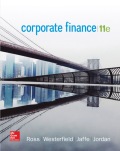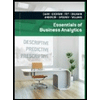
EBK CORPORATE FINANCE
11th Edition
ISBN: 8220102798878
Author: Ross
Publisher: YUZU
expand_more
expand_more
format_list_bulleted
Question
Chapter 10, Problem 9QP
a)
Summary Introduction
To determine: The returns and variability
Introduction:
The term return refers to a profit or gain made on an investment that is usually expressed in terms of percentage or dollars. The percentage total return shows the overall performance and efficiency of the amount invested.
The arithmetic average return is the average amount of money made by a particular investment. The variance determines the variances among the yearly returns of the stock. The standard deviation is simply the square root of calculated variance that measures the volatility of an investment.
(b)
Summary Introduction
To determine: variance of company’s stock and standard deviation of company’s stock.
Expert Solution & Answer
Want to see the full answer?
Check out a sample textbook solution
Students have asked these similar questions
An investment that is worth $44,600 is expected to pay you $212,205 in X years and has an expected return of 18.05 percent per year.
What is X?
An investment that is worth $27,200 is expected to pay you $62,280 in 5 years and has an expected return of X percent per year.
What is X?
Don't used Ai solution and don't used hand raiting
Chapter 10 Solutions
EBK CORPORATE FINANCE
Ch. 10 - Investment Selection Given that RadNet was up by...Ch. 10 - Investment Selection Given that Transocean was...Ch. 10 - Risk and Return We have seen that over long...Ch. 10 - Prob. 4CQCh. 10 - Effects of inflation Look at Table 10.1 and Figure...Ch. 10 - Risk Premiums Is it possible for the risk premium...Ch. 10 - Prob. 7CQCh. 10 - Returns Two years ago, the Lake Minerals and Small...Ch. 10 - Prob. 9CQCh. 10 - Historical Returns The historical asset class...
Ch. 10 - Calculating Returns Suppose a stock had an initial...Ch. 10 - Calculating Yields In Problem 1, what was the...Ch. 10 - Calculating Returns Rework Problems 1 and 2...Ch. 10 - Prob. 4QPCh. 10 - Prob. 5QPCh. 10 - Bond Returns What is the historical real return on...Ch. 10 - Calculating Returns and Variability Using the...Ch. 10 - Risk Premiums Refer to Table 10.1 in the text and...Ch. 10 - Prob. 9QPCh. 10 - Prob. 10QPCh. 10 - Calculating Real Rates Given the information in...Ch. 10 - Holding Period Return A stock has had returns of...Ch. 10 - Prob. 13QPCh. 10 - Prob. 14QPCh. 10 - Calculating Returns You bought a stock three...Ch. 10 - Calculating Real Returns Refer to Table 10.1. What...Ch. 10 - Return Distributions Refer back to Table 10.2....Ch. 10 - Prob. 18QPCh. 10 - Calculating Returns and Variability You find a...Ch. 10 - Arithmetic and Geometric Returns A stock has had...Ch. 10 - Arithmetic and Geometric Returns A stock has had...Ch. 10 - Calculating Returns Refer to Table 10.1 in the...Ch. 10 - Prob. 23QPCh. 10 - Using Return Distributions Suppose the returns on...Ch. 10 - Using Return Distributions Assuming that the...Ch. 10 - Prob. 26QPCh. 10 - Using Probability Distributions Suppose the...Ch. 10 - Prob. 28QPCh. 10 - Prob. 1MCCh. 10 - Prob. 2MCCh. 10 - Assume you decide you should invest at least part...Ch. 10 - Prob. 4MCCh. 10 - A measure of risk-adjusted performance that is...Ch. 10 - What portfolio allocation would you choose? Why?...
Knowledge Booster
Similar questions
- 3-7. (Working with an income statement and balance sheet) Prepare a balance sheet and income statement for Kronlokken Company from the following scrambled list of items. a. Prepare a common-sized income statement and a common-sized balance sheet. Interpret your findings. Depreciation expense $66,000 Cash 225,000 Long-term debt 334,000 Sales 573,000 Accounts payable 102,000 General and administrative expense 79,000 Buildings and equipment 895,000 Notes payable 75,000 Accounts receivable 153,000 Interest expense 4,750 Accrued expenses 7,900 Common stock 289,000 Cost of goods sold 297,000 Inventory 99,300 Taxes 50,500 Accumulated depreciation 263,000 Prepaid expenses 14,500 Taxes payable 53,000 Retained earnings 262,900 ||arrow_forwardx3-3. (Preparing an income statement) Prepare an income statement and a common- sized income statement from the following information. MyLab Sales Cost of goods sold General and administrative expenses Depreciation expenses Interest expense Income taxes $525,000 200,000 62,000 8,000 12,000 97,200arrow_forward3-9. (Working with a statement of cash flows) Given the following information, prepare LO3 a statement of cash flows. Increase in accounts receivable Increase in inventories Operating income Interest expense Increase in accounts payable Dividends $25 30 75 25 25 15 20 Increase in net fixed assets 23 Depreciation expense Income taxes 12 17 Beginning cash 20 Increase in common stockarrow_forward
- 3-4. (Preparing a balance sheet) Prepare a balance sheet from the following informa- LO2 tion. What is the net working capital and debt ratio? Cash $50,000 Account receivables 42,700 Accounts payable 23,000 Short-term notes payable 10,500 Inventories 40,000 Gross fixed assets 1,280,000 Other current assets 5,000 Long-term debt 200,000 Common stock 490,000 Other assets 15,000 Accumulated depreciation 312,000 Retained earnings ? MyLabarrow_forwardPlease help with questions.arrow_forwardWhat is the research design? How does it work? What are the differences between Research design and Case Study research?arrow_forward
- How to judge the quality of research designs? Could you help explain and give examples?arrow_forwardConsider a situation involving determining right and wrong. Do you believe utilitarianism provides a more objective viewpoint than moral rights in this context? Why or why not? How about when comparing utilitarianism to principles of justice? Share your thoughts. Reflect on this statement: "Every principle of distributive justice, whether that of the egalitarian, the capitalist, the socialist, the libertarian, or Rawls, in the end is illegitimately advocating some type of equality." Do you agree or disagree with this assertion? Why might someone claim this, and how would you respond?arrow_forwardI need help checking my spreadsheet. Q: Assume that Temp Force’s dividend is expected to experience supernormal growth of 73%from Year 0 to Year 1, 47% from Year 1 to Year 2, 32% from Year 2 to Year 3 and 21% from year3 to year 4. After Year 4, dividends will grow at a constant rate of 2.75%. What is the stock’sintrinsic value under these conditions? What are the expected dividend yield and capital gainsyield during the first year? What are the expected dividend yield and capital gains yield duringthe fifth year (from Year 4 to Year 5)?arrow_forward
- what are the five components of case study design? Please help explain with examplesarrow_forwardCommissions are usually charged when a right is exercised. a warrant is exercised. a right is sold. all of the above will have commissions A and B are correct, C is not correctarrow_forwardWhat is Exploratory Research Case Study? What is the main purpose of Exploratory Research?arrow_forward
arrow_back_ios
SEE MORE QUESTIONS
arrow_forward_ios
Recommended textbooks for you
 EBK CONTEMPORARY FINANCIAL MANAGEMENTFinanceISBN:9781337514835Author:MOYERPublisher:CENGAGE LEARNING - CONSIGNMENT
EBK CONTEMPORARY FINANCIAL MANAGEMENTFinanceISBN:9781337514835Author:MOYERPublisher:CENGAGE LEARNING - CONSIGNMENT
 Essentials Of Business AnalyticsStatisticsISBN:9781285187273Author:Camm, Jeff.Publisher:Cengage Learning,
Essentials Of Business AnalyticsStatisticsISBN:9781285187273Author:Camm, Jeff.Publisher:Cengage Learning,


EBK CONTEMPORARY FINANCIAL MANAGEMENT
Finance
ISBN:9781337514835
Author:MOYER
Publisher:CENGAGE LEARNING - CONSIGNMENT


Essentials Of Business Analytics
Statistics
ISBN:9781285187273
Author:Camm, Jeff.
Publisher:Cengage Learning,